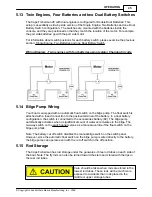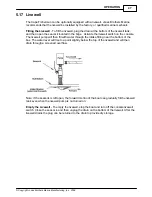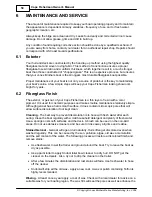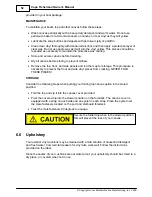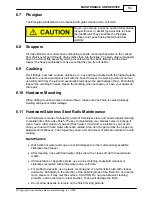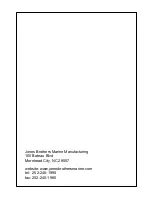
Cape Fisherman Owner's Manual
56
© Copyright Jones Brothers Marine Manufacturing, Inc. 2008
7
WINTERIZATION AND STORAGE
If your boat is going to be stored for the winter or for an extended period of time, there are
some routine operations that should be taken care of. This information is presented as a
general guide and the actual storage should be performed by a professional, qualified
dealership. Prior to and during the storage process, the boat and it's systems should be
checked for any maintenance and repairs. Arrange maintenance and repairs during the
storage period.
To avoid costly damage and delay when launching your boat, have it stored and winterized
properly. Listed below are some of the general guidelines that should be considered before
storage.
7.1
Boat Storage
If storing your boat on the trailer, raise and block the trailer axle to prevent tire deterioration.
This is an excellent time to lubricate and pack the wheel bearings per manufacturer's
instructions.
Indoor storage is advantageous in many ways, particularly if your climate produces ice and
snow. The storage building should not be sealed airtight, but should be sufficiently
ventilated. Ventilation is extremely important both around and through the boat.
To prevent "sweating," a breathable cloth or canvas cover should be used for outdoor
storage. Consider building a frame to support the canvas. It should be slightly wider than
the boat so the canvas will clear the rails and allow passage of air. The cover should be
securely fastened so that winds cannot remove it or cause it to chafe the boat. A poor
covering job will cost more than the price of a well-made cover.
7.2
Cleaning and Lubricating the Boat
Clean and wax your boat before storage. If you store your boat in the water, there may be a
layer of growth on the bottom. As it dries, this debris will harden. Clean, scrub, and scrape
the bottom promptly when the boat is removed from the water. Thoroughly remove marine
growth and other foreign matter from the hull. Clean the inside of all hull openings, thru hull
fittings and scupper drains. Inspect the hull bottom for any damage.
Check cleats and rails for corrosion and tightness. Clean all stainless steel. Use a good
quality metal preservative like Formula 6-56 lubricant from CRC Chemicals on all metal
surfaces to prevent salt water damage. Check for loose silicone, hinged, and unseated
gaskets. Replace or tighten where necessary. Check all hinges for corrosion and lubricate.
7.3
Draining the Boat
Remove the bilge drain plug and open all valves and seacocks to keep the bilge dry. Store
your boat with the bow elevated for drainage.
If your boat has a salt water washdown system and/or livewell, drain all the lines before
storage.
Summary of Contents for Cape Fisherman
Page 1: ...Cape Fisherman Owner s Manual...
Page 6: ......
Page 7: ...WELCOME Part I...
Page 9: ...OVERVIEW Part II...
Page 12: ......
Page 13: ...BOATING SAFETY Part III...
Page 26: ......
Page 27: ...GENERAL BOATING INFORMATION Part IV...
Page 37: ...OPERATION Part V...
Page 55: ...MAINTENANCE AND SERVICE Part VI...




